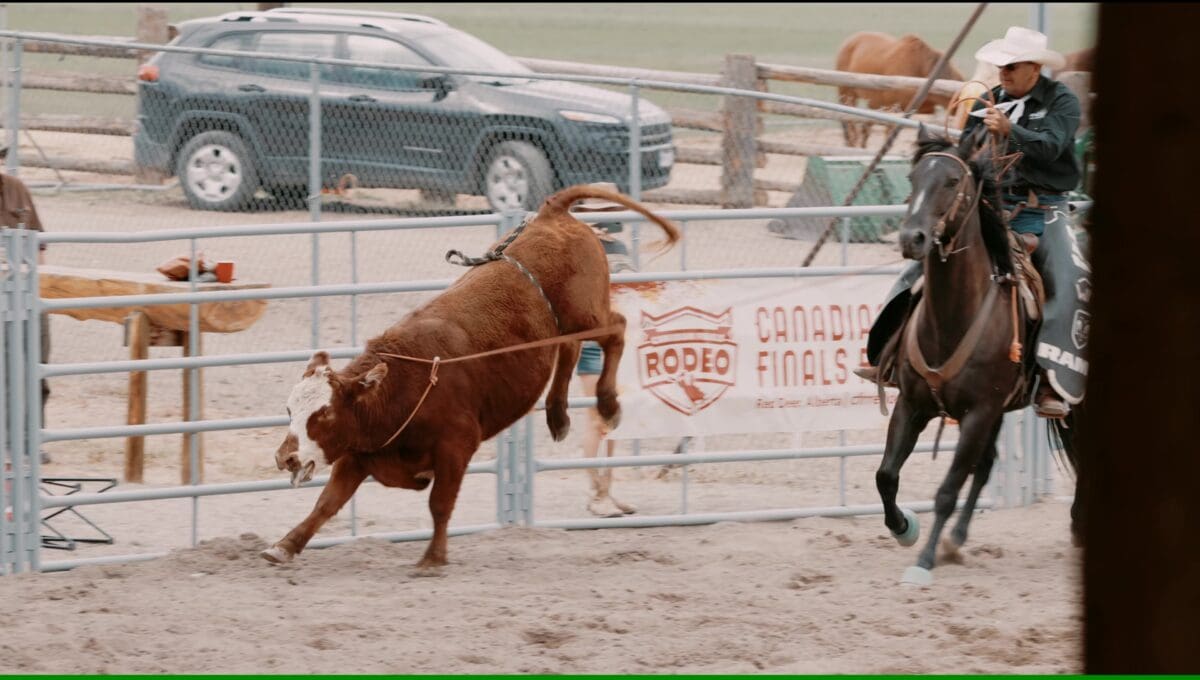Article originally published in the Daily Hive.
Bring up animal welfare to a rodeo supporter, and you’ll often hear the same set of arguments: these animals are trained. They’re used to it. They’re athletes akin to other rough sports, like football or boxing. While these arguments are easily unravelled, new footage from this year’s rodeo in Merritt kicks the legs out from under them entirely.
The newly released footage taken by the Vancouver Humane Society shows handlers aggressively pulling and twisting a steer’s tail in the chute as he falls to his knees. Footage also shows steers with flank straps tightened around their sensitive underbellies and panic in their eyes, bucking wildly as saliva spurts from their mouths. Several animals become so agitated that they slip and fall to the ground of the arena.
It’s common to see handling techniques like the ones shown in this video used in rodeo events. Pulling an animal’s tail or shaking their head initiates their “fight or flight” fear response, which causes them to perform the behaviours expected in a rodeo event: running away at high speeds or bucking violently.
Generally, a compassionate observer can see the signs of stress in animals subjected to this treatment, including visible whites around the animals’ eyes, extended tongues, and excessive drooling. The reactions of the steers at the Nicola Valley Rodeo in Merritt are far more obvious, however. A look at the Pro Rodeo website tells us why.
The Nicola Valley Rodeo page on the Canadian Professional Rodeo Association website lists the Steer Riding Contractor as “local beef cattle,” which suggests these steers are from a nearby farm and not a rodeo stock contractor who raises and keeps animals specifically for the purpose of being used in rodeo events.
Animals from farms are not accustomed to the fast pace of rodeos; in fact, the National Farm Animal Care Council’s Beef Cattle Code of Practice, which serves as an industry guideline for the care and handling of beef cattle in Canada, requires that quiet handling techniques be used on farms. The high-speed, rough nature of animal handling in rodeo events is completely contradictory to the handling guidelines for these same animals in a farm setting.
Where other rodeo animals may have become accustomed to the stressful and rough handling inherent to the sport, this video footage reveals what could very well be these animals’ first rodeo.
Of course, it would be erroneous to say that other animals who are used to rodeos no longer feel fear and stress. Adverse reactions from other rodeo animals can be seen in footage from this year’s BC rodeo events as well: a calf defecates as they are pulled along the ground by a rope fastened around their neck; a bucking horse jumps over a fence, landing on their shoulder; and multiple clips show animals thrashing around in rodeo chutes and resisting handlers.
In other cases, the animals’ relatively subtle response to stressful stimuli like flank straps, ear pulling, and tail twisting could be a result of learned helplessness.
Learned helplessness is a psychological state that animals can experience when they repeatedly face a stressful situation over which they have no control. Though they continue to experience a heightened stress response, they lose motivation to try to change their situation and appear passive.
Because these individual beef cattle have likely not become resigned to the treatment common in rodeos, their responses offer the public a glimpse into what the beginning of the journey may look like for all rodeo animals. After all, every animal used in these events has experienced a “first rodeo.”
Animals used in timed events like roping, wrestling, and bucking must endure multiple rodeos each season; they face stressful travel between events; and they experience hours of use in rodeo practice sessions, where less polished iterations of the rodeo events seldom reach the public eye.
Being used again and again for the sake of public entertainment does not transform frightened animals into willing athletes. Despite the pomp and pageantry about rodeo animals and human athletes working together in events, the two parties have remarkably little in common.
Real athletes understand the rules of the game. They make the decision to sign up and prepare for events. They do not need to be coerced into the arena through the use of physical discomfort and pain. Each time they perform, it’s because they’ve chosen to do so.
Animals don’t have the capacity to do this. They do not understand the concept of “winning” at so-called sports designed by and for humans. They can, of course, try to opt out of events by simply standing still – despite the stimuli activating their fight or flight instincts and at the risk of being punished for their disobedience.
Most importantly, where athletes’ first rodeos are marked with excitement, this year’s videos prove once again that animals’ journeys are marked by fear.
With growing opposition to these events and so many other ways to celebrate BC’s vibrant community, the continued use of stressed animals for public entertainment makes less sense than ever. It’s high time for the province to buck the inhumane rodeo tradition.

